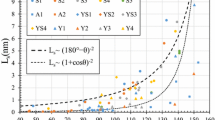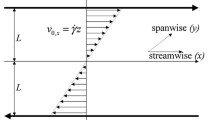Abstract
Three-dimensional Molecular Dynamics (MD) simulations of heat and momentum transport in liquid Argon filled shear-driven nano-channels are performed using 6–12 Lennard–Jones potential interactions. Work done by the viscous stresses heats the fluid, which is dissipated through the channel walls, maintained at isothermal conditions through a recently developed interactive thermal wall model. Shear driven nano-flows for weak wetting surfaces (ε wf /ε ≤ 0.6) are investigated. Spatial variations in the fluid density, kinematic viscosity, shear- and energy dissipation rates are presented. Temperature profiles in the nano-channel are obtained as a function of the surface wettability, shear rate and the intermolecular stiffness of wall molecules. The energy dissipation rate is almost a constant for ε wf /ε ≤ 0.6, which results in parabolic temperature profiles in the domain with temperature jumps due to the well known Kapitza resistance at the liquid/solid interfaces. Using the energy dissipation rates predicted by MD simulations and the continuum energy equation subjected to the temperature jump boundary conditions developed in [Kim et al. Journal of Chemical Physics, 129, 174701, 2008b], we obtain analytical solutions for the temperature profiles, which agree well with the MD results.










Similar content being viewed by others
References
Allen MP, Tildesley DJ (1989) Computer simulation of liquids. Oxford University Press, New York
Cahill DG, Ford WK, Goodson KE, Mahan GD, Majumdar A, Maris HJ, Merlin R, Phillpot SR (2003) Nanoscale thermal transport. J Appl Phys 93(2):793–818
Cieplak M, Koplik J, Banavar JR (1999) Applications of statistical mechanics in subcontinuum fluid dynamics. Physica A 274(1–2):281–293
Cieplak M, Koplik J, Banavar JR (2001) Boundary conditions at a fluid–solid interface. Phys Rev Lett 86(5):803–806
Evans DJ, Hoover WG (1986) Flows far from equilibrium via molecular-dynamics. Annu Rev Fluid Mech 18:243–264
Ge ZB, Cahill DG, Braun PV (2006) Thermal conductance of hydrophilic and hydrophobic interfaces. Phys Rev Lett 96(18):186101
Jabbarzadeh A, Atkinson JD, Tanner RI (1999) Wall slip in the molecular dynamics simulation of thin films of hexadecane. J Chem Phys 110(5):2612–2620
Kapitza PL (1941) The study of heat transfer in helium II. J Phys 4(1–6):181–210
Karniadakis G, Beskok A, Aluru N (2005) Microflows and nanoflows fundamentals and simulation. In: Microflows and nanoflows fundamentals and simulation. Springer Science, New York
Khare R, dePablo J, Yethiraj A (1997) Molecular simulation and continuum mechanics study of simple fluids in non-isothermal planar couette flows. J Chem Phys 107(7):2589–2596
Kim BH, Beskok A, Cagin T (2008a) Thermal interactions in nanoscale fluid flow: molecular dynamics simulations with solid–liquid interfaces. Microfluid Nanofluidics 5(4):551–559
Kim BH, Beskok A, Cagin T (2008b) Molecular dynamics simulations of thermal resistance at the liquid–solid interface. J Chem Phys 129:174701
Koplik J, Banavar JR (1995) Continuum deductions from molecular hydrodynamics. Annu Rev Fluid Mech 27:257–292
Koplik J, Banavar JR, Willemsen JF (1988) Molecular-dynamics of poiseuille flow and moving contact lines. Phys Rev Lett 60(13):1282–1285
Koplik J, Banavar JR, Willemsen JF (1989) Molecular-dynamics of fluid-flow at solid-surfaces. Phys Fluids A 1(5):781–794
Liem SY, Brown D, Clarke JHR (1992) Investigation of the homogeneous-shear nonequilibrium-molecular-dynamics method. Phys Rev A 45(6):3706–3713
Nagayama G, Cheng P (2004) Effects of interface wettability on microscale flow by molecular dynamics simulation. Int J Heat Mass Transf 47(3):501–513
Ohara T, Torii D (2005) Molecular dynamics study of thermal phenomena in an ultrathin liquid film sheared between solid surfaces: the influence of the crystal plane on energy and momentum transfer at solid–liquid interfaces. J Chem Phys 122:214717
Priezjev NV (2007) Rate-dependent slip boundary conditions for simple fluids. Phys Rev E 75(5):051605
Priezjev NV, Darhuber AA, Troian SM (2005) Slip behavior in liquid films on surfaces of patterned wettability: comparison between continuum and molecular dynamics simulations. Phys Rev E 71(4):041608
Sofos F, Karakasidis T, Liakopoulos A (2009a) Transport properties of liquid argon in krypton nanochannels: anisotropy and non-homogeneity introduced by the solid walls. Int J Heat Mass Transf 52(3–4):735–743
Sofos F, Karakasidis T, Liakopoulos A (2009b) Non-equilibrium molecular dynamics investigation of parameters affecting planar nanochannel flows. Contemp Eng Sci 2(6):283–298
Tenenbaum A (1983) Local equilibrium in stationary states by molecular-dynamics. Phys Rev A 28(5):3132–3133
Tenenbaum A, Ciccotti G, Gallico R (1982) Stationary non-equilibrium states by molecular-dynamics—fourier law. Phys Rev A 25(5):2778–2787
Thomas JA, McGaughey AJH (2007) Effect of surface wettability on liquid density, structure, and diffusion near a solid surface. J Chem Phys 126(3):034707
Thompson PA, Robbins MO (1990) Shear-flow near solids—epitaxial order and flow boundary-conditions. Phys Rev A 41(12):6830–6837
Thompson PA, Troian SM (1997) A general boundary condition for liquid flow at solid surfaces. Nature 389(6649):360–362
Tseng HC, Wu JS, Chang RY (2008) Shear thinning and shear dilatancy of liquid n- hexadecane via equilibrium and nonequilibrium molecular dynamics simulations: temperature, pressure, and density effects. J Chem Phys 129(1):014502
Volz S, Saulnier JB, Lallemand M, Perrin B, Depondt P, Mareschal M (1996) Transient Fourier-law deviation by molecular dynamics in solid argon. Phys Rev B 54(1):340–347
Xu P, Cagin T, Goddard WA (2005) Assessment of phenomenological models for viscosity of liquids based on nonequilibrium atomistic simulations of copper. J Chem Phys 123(10):104506
Xue L, Keblinski P, Phillpot SR, Choi SUS, Eastman JA (2004) Effect of liquid layering at the liquid–solid interface on thermal transport. Int J Heat Mass Transf 47(19–20):4277–4284
Author information
Authors and Affiliations
Corresponding author
Rights and permissions
About this article
Cite this article
Kim, B.H., Beskok, A. & Cagin, T. Viscous heating in nanoscale shear driven liquid flows. Microfluid Nanofluid 9, 31–40 (2010). https://doi.org/10.1007/s10404-009-0515-5
Received:
Accepted:
Published:
Issue Date:
DOI: https://doi.org/10.1007/s10404-009-0515-5




